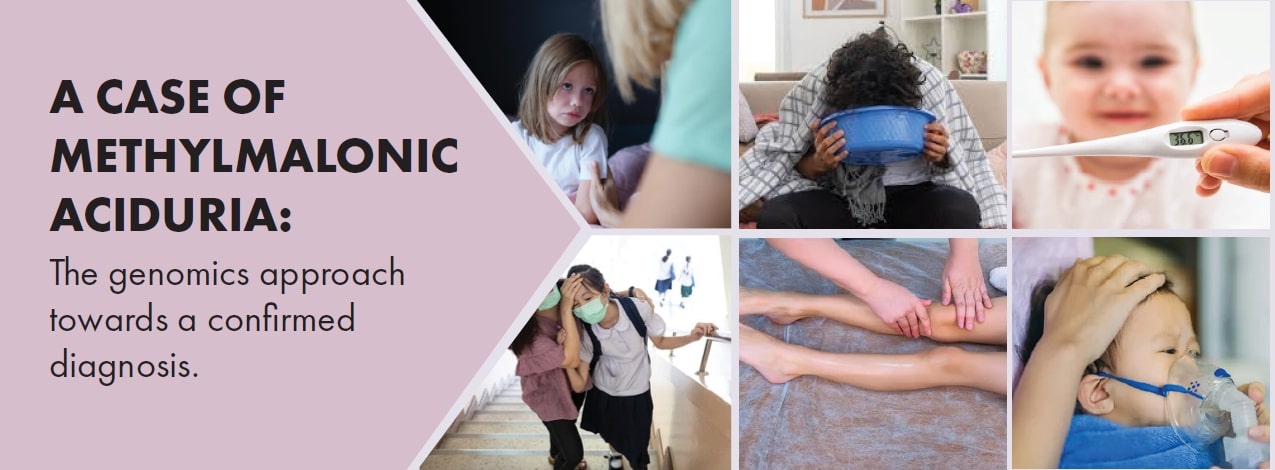
A Sandor Initiative Towards Richer Clinical Insights
CASE BULLETINS
Disclaimer: This newsletter is intended to enrich the insights related to genetic disorders from a laboratory perspective. The objective of this newsletter is to share knowledge from a lab perspective to facilitate the dialogue of genetic disorders diagnosis. We want to sincerely thank the physicians whose dedication, knowledge and intelligence helps arrive at answers through diagnosis enabling timely and effective prevention.

ABOUT THE DISEASE
Methylmalonic acidemia with homocystinuria is an inherited disorder in which the body is unable to properly process protein building blocks (amino acids), certain fats (lipids), and a waxy fat-like substance called cholesterol. When the condition begins early in life, affected individuals typically have failure to thrive, IUGR, pallor, hypotonia, seizures. Most infants and children with this condition have microcephaly, delayed development and intellectual disability¹ . Less common features of the condition include eye problems and a blood disorder called megaloblastic anemia. When methylmalonic acidemia with homocystinuria begins in adolescence or adulthood, the signs and symptoms usually include psychiatric changes and cognitive problems ² .
In addition, these individuals can begin to lose previously acquired mental and movement abilities, resulting in a decline in school or work performance, difficulty controlling movements, memory problems, speech difficulties, a decline in intellectual function (dementia), or an extreme lack of energy (lethargy). The most common form of the condition, called methylmalonic acidemia with homocystinuria, cblC type, is estimated to affect 1 in 200,000 newborns worldwide.Methylmalonic acidemia with homocystinuria can be caused by mutations in one of several genes: MMACHC, MMADHC, LMBRD1, ABCD4, or HCFC1. Methylmalonic acidemia with homocystinuria is usually inherited in an autosomal recessive pattern ³ .
CASE REFERRED TO SANDOR
A 3-years Male Child Born Of Third-degree Consanguineous Marriage Presented With:
- Global developmental delay
- Recurrent Spasms
- Epileptic Encephalopathy
- Bulbar dysfunction
- Nystagmus
- Increased brisk reflexes
- Visual Inattention
- EEG- Showed generalized epileptiform activity over both hemispheres.
- TMS, GCMS, biotinidase study, Amino acid profile, acyl carnitine protein was NORMAL
Tests Prescribed :
- Whole Exome Sequencing
| Test Name | Sample Type | Method | |
|---|---|---|---|
| Whole Exome Sequencing | 2-4 EDTA Blood | Next Generation Sequencing | Mean coverage of 80-100X coverage. Target coverage 200X |
Whole Exome Sequencing: A homozygous likely pathogenic variant was found in the MMACHC gene (Table.1)
Table 1 Whole Exome Sequencing result
| Gene & Transcript | Variant | Location | Zygosity | Disorder (OMIM) | Inheritance |
|---|---|---|---|---|---|
| MMACHCNM_015506.3 | c.394C> T(p.Arg132Ter) |
Exon 3 | Homozygous | Methylmalonic aciduria & Homocystinuria CblC type (277400) |
Autosomal Recessive |
- The clinical suspicion of cblC disease should lead to the immediate analysis of urine organic acids, serum MMA, tHcy, plasma amino acids and an acylcarnitine profile followed by mutation analysis.
- Individuals with combined methylmalonic acidemia and homocystinuria respond to a combined treatment consisting of supplementation of hydroxy cobalamin, betaine, folic acid, vitamin B6 and L-carnitine with clinical and biochemical improvement.
- The early prenatal diagnosis of cblC disease is possible by molecular analysis of chorionic villus cells or cultured amniocytes.
- Exome sequencing along with measurement of enzyme activity analysis can significantly improve the diagnostic yield.
| Name | Designation | Contribution |
|---|---|---|
| Mr. Nadir Aman | Genetic Counselor | Compilation |
| Ms. Vineeta Singh | Vice President-Scientific Affairs | Exome Analysis |
References:
- 1Medline Plus,Medline Plus,https://medlineplus.gov/genetics/...Click here
- Rare Diseases,Rare Diseases, https://rarediseases.info.nih.gov/...Click here
- OMIM, https://www.omim.org/entry/277400
- https://pubmed.ncbi.nlm.nih.gov/23751581
- Combined methylmalonic acidemia and homocystinuria, cblC type. I. Clinical presentations, diagnosis & management, Nuria Carrillo-Carrasco & Randy J. Chandler & Charles P. Vendittis, 2011, DOI 10.1007/s10545-011-9364-y